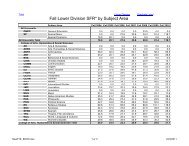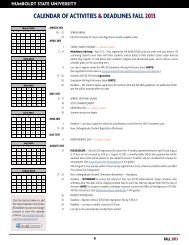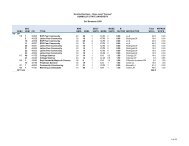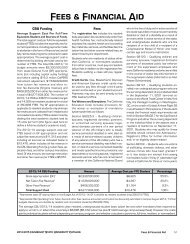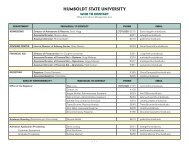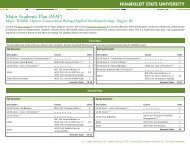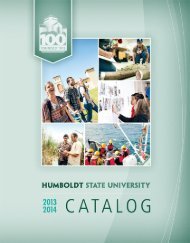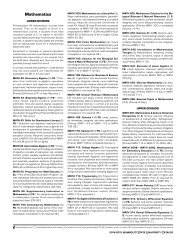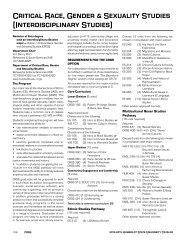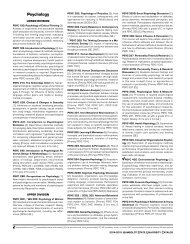2007-08 Academic Year - Humboldt State University
2007-08 Academic Year - Humboldt State University
2007-08 Academic Year - Humboldt State University
You also want an ePaper? Increase the reach of your titles
YUMPU automatically turns print PDFs into web optimized ePapers that Google loves.
many, Austria, or Switzerland. Also the Children’s<br />
Language Academy. [Prereq: IA. Rep.]<br />
GERM 499. Directed Study (1-3). Directed reading.<br />
[Hours TBA. Rep.]<br />
Health Education<br />
LOWER DIVISION<br />
HED 115. First Aid/CPR (1). Conforms to American<br />
Red Cross standards. Lectures, demonstrations,<br />
and practical applications. Those passing<br />
written exams and skill tests are recommended<br />
for first aid and CPR certification. [CR/NC. Rep<br />
for renewal of certification.]<br />
HED 120. Responding to Emergencies-CPRFPR<br />
(1). Course includes American Red Cross First<br />
Aid, Adult CPR, Adult AED, Child CPR, Child AED,<br />
and infant CPR. Leads to first-time certification or<br />
re-certification of these courses. [Rep. 4]<br />
HED 231. Basic Human Nutrition (3). Nutrient<br />
requirements for healthy living. Analyze food<br />
sources, function of nutrients, chemical processing,<br />
and food absorption. [Prereq: CHEM 105<br />
or 109. CAN FCS 2.]<br />
UPPER DIVISION<br />
HED 312. First Aid Instructor (2). American Red<br />
Cross First Aid instructor course.<br />
HED 342. Nutrition for Athletic Performance<br />
(3). How food consumption and nutrition affect<br />
energy production and physical performance in<br />
sports activities. Analyze diet modifications, such<br />
as carbohydrate loading and use of ergogenic aids,<br />
to improve performance.<br />
HED 344. Weight Control (3). Theories and<br />
practices related to maintaining safe and healthy<br />
weight levels. Diet analysis; body composition and<br />
effects of exercise; behavior modification.<br />
HED 388. Health-Related Behavior Change<br />
(3). Determinants of health-related behavior.<br />
Principles of behavior change applied to personal<br />
and environmental health. Methods for promoting<br />
sustainable health behavior change at the<br />
individual, group, and community levels.<br />
HED 390. Design & Implement HP Program<br />
(3). Planning, implementing and evaluating health<br />
promotion programs for different populations and<br />
different settings.<br />
HED 392. Community & Population Health<br />
(3). Introduction to public health, epidemiology,<br />
structure, and function of the health care<br />
system and environmental health. Methods for<br />
addressing health needs in different populations<br />
and settings.<br />
HED 400. A Sound Mind in a Sound Body:<br />
Human Integration (3). Optimum health. Sound<br />
mind in a sound body (interrelationship), exercise<br />
physiology, human sexuality and childbirth, nutrition,<br />
stress, death/dying, psychophysiology and<br />
behavior, holistic medicine, somatology. [Prereq:<br />
minimum junior standing. GE.]<br />
HED 400I. The Silk Road (3). “Virtual journey”<br />
along medieval trade route (the Silk Road) that<br />
connected Europe with Central, South, and East<br />
Asia. Intercultural communication, social scientific<br />
analysis, and human integration. Field trips to City<br />
of 10,000 Buddhas, San Francisco’s Asia Art<br />
Museum, and Chinatown.<br />
HED 405. School Health Programs (3). Basic<br />
personal and school health issues: drug use and<br />
abuse, nutrition, sexually transmitted diseases,<br />
safety and liability, consumer education, common<br />
school-age illnesses, death and dying, human sexuality,<br />
and stress. CPR training and certification.<br />
Meets health education requirement for teaching<br />
credential.<br />
HED 444. Wellness in the Workplace (2). Rationale<br />
for employee health promotion programs.<br />
Corporate needs; components of successful<br />
programs; evaluation.<br />
HED 446. Optimal Bone & Muscle Development<br />
(3). An in depth study of energy systems, hormonal<br />
regulatory mechanisms, and the synergistic aspects<br />
of exercise and nutrition related to maintenance,<br />
repair, and strength development of bone<br />
and muscle. [Prereq: HED 342 OR HED 231.]<br />
HED 495. Directed Field Experience (1-6).<br />
Assigned field experience under supervision of<br />
college staff. [Prereq: DA. Rep.]<br />
HED 499. Directed Study (1-6). Supervised independent<br />
study of areas not covered by scheduled<br />
courses. [Rep.]<br />
GRADUATE<br />
HED 500. Cardiac Rehabilitation (3). Human<br />
cardiopulmonary system; abnormalities in heart<br />
and respiratory functions; exercise program; exercise<br />
testing. [Prereq: IA.]<br />
HED 695. Directed Field Experience (3-6).<br />
Active, approved, practical field assignment. Performance<br />
analyzed by supervising staff. [Rep.]<br />
CREDENTIAL/LICENSURE<br />
HED 705. School Health Programs (3). Basic<br />
personal and school health issues: drug use and<br />
abuse, nutrition, sexually transmitted diseases,<br />
safety and liability, consumer education, common<br />
school-age illnesses, death/dying, human sexuality,<br />
and stress. CPR training and certification.<br />
Meets health education requirement for teaching<br />
credential.<br />
History<br />
LOWER DIVISION<br />
HIST 104. Western Civilization to 1650 (3)<br />
FS. Origin and growth of human communities<br />
in the Western world. Development of various<br />
social and political organizations, cultural milieu,<br />
and relationships to the rest of the world. [CAN<br />
HIST 2. GE.]<br />
HIST 105. Western Civilization, 1650 to Present<br />
(3) FS. Diverse development of Western political<br />
and social institutions. Impact of economic,<br />
political, scientific, and technological change.<br />
Varieties of cultural milieu. Relationships to the<br />
rest of the world. [CAN HIST 4. GE.]<br />
HIST 107. East Asian History to 1644 (3).<br />
China, Korea, and Japan from prehistory to 1644.<br />
Early China, Japan, Korea, and Vietnam: their history<br />
and arts. [GE.]<br />
HIST 1<strong>08</strong>. East Asian Civilization Since 1644<br />
(3). China, Japan, Korea, and Vietnam from 1644<br />
to the present, emphasizing the maturing of East<br />
Asian civilization as it encountered the West. [GE.]<br />
HIST 109. Colonial Latin American History (3).<br />
Pre-Columbian and colonial Latin America to 19th<br />
century independence movements. [GE.]<br />
HIST 109B. Modern Latin America (3). Major<br />
themes/problems in history of Latin America<br />
from early 1800s (independence) to present.<br />
[GE.]<br />
HIST 110. United <strong>State</strong>s History to 1877 (3)<br />
FS. Selected topics. Sources and conditioning<br />
factors of American social, political, and economic<br />
systems to 1877. Meets requirement in<br />
US history established by California legislature.<br />
[CAN HIST 8]<br />
HIST 111. United <strong>State</strong>s History from 1877<br />
(3) FS. Selected topics. Sources and conditioning<br />
factors of American social, political, and economic<br />
systems from 1877. Meets requirement in US<br />
history established by California legislature. [CAN<br />
HIST 10]<br />
HIST 199. Discussion Lab (1). Discuss readings,<br />
films, and/or computer resources. [Rep<br />
3 times.]<br />
HIST 210. Introduction to History (4). Nature<br />
of history; historical consciousness; historians’<br />
craft; use of primary/secondary sources. Recommended<br />
first course in the major. One of four units<br />
is individualized instruction on assigned essay.<br />
HIST 211. Intro to History for Teachers (4).<br />
Research skills, citation, primary/secondary<br />
sources, critical thinking, historical methodologies,<br />
historiography, alignment with K-12 social science<br />
standards. Emphasis on writing and discussion.<br />
(Coreq: HIST 226, SED 210, SED 410.]<br />
HIST 226. Computer Research in History (1).<br />
How to do historical research on the internet,<br />
locate and use primary sources and databases<br />
and determine the validity of Web sites.<br />
UPPER DIVISION<br />
HIST 300. The Era of World War I (3-4). Setting<br />
and development. Social, economic, and political<br />
changes wrought by the war. Four units to be taken<br />
by majors only. [GE.]<br />
HIST 301. The Era of World War II (3-4). Setting<br />
and development. Social, economic, and political<br />
impact of total war upon modern society. Films,<br />
readings, lectures. Four units to be taken by<br />
majors only. [GE.]<br />
HIST 305. The American West, 1763-1900<br />
(3-4). Diverse American peoples and their<br />
frontier experiences between Appalachians and<br />
Pacific Coast. Four units to be taken by majors<br />
only. [GE.]<br />
HIST 309. Revolution, Reform, Response (3).<br />
20th century Latin America: theme of revolution.<br />
Emphases: Mexico, Guatemala, Nicaragua, Cuba,<br />
Argentina. [Part of 9-unit package with SPAN<br />
activ activity; (C) may be concurrent; CAN California articulation number; coreq corequisite(s); CR/NC mandatory credit/no credit; CWT communication & ways of thinking; DA dept approval<br />
218 German<br />
<strong>2007</strong>-20<strong>08</strong> <strong>Humboldt</strong> <strong>State</strong> <strong>University</strong> Catalog



